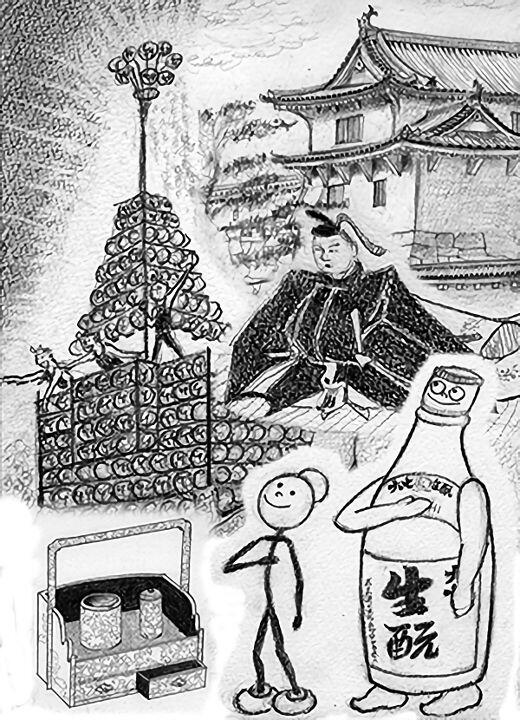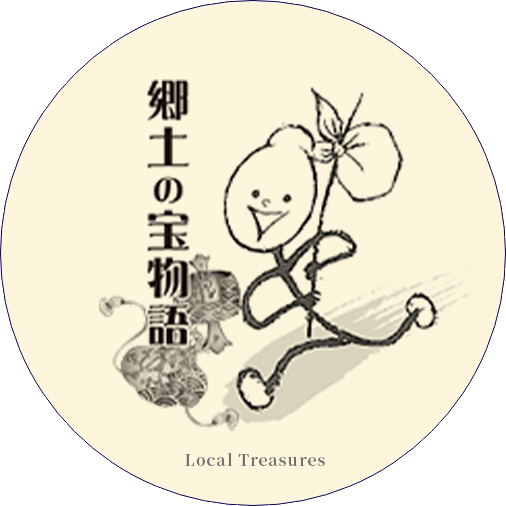| Yeast |
“As treasures of Nihonmatsu we have both the castle and the history of the domain lords. I hear you have met with the 18th generation of the Niwa family, Nagatoshi Niwa?” |
| Kimoto |
“Yes, I received a lot of important information from him. To begin with, the first Niwa lord was Nagahide Niwa (1535-1585), who lived in the Age of Warring States.” |
| Yeast |
“A famous warlord who is also mentioned in schoolbooks!” |
| Kimoto |
“Indeed. He demonstrated his skills in the service of Nobunaga Oda (1534-1582). He was counted among the Best Four Generals serving Nobunaga, and was very trusted. He even married the adopted daughter of Nobunaga (originally Nobunaga’s niece). After the death of Nobunaga he was also admired by Hideyoshi Toyotomi. He became a domain lord with a territory of 1,230,000 koku of rice production, spanning the old provinces of Echizen, Wakasa, and Kaga.” |
| Yeast |
“Impressive! That means he was a great daimyo (feudal ruler)!” |
| Kimoto |
“But in the second generation, that of Lord Nagashige Niwa, the territory was reduced to only 40,000 koku! His life knew dramatic ups and downs!” |
| Yeast |
“Why was that?” |
| Kimoto |
“When Nagashige became family head, he was only at the tender age of 15. Hideyoshi used his immaturity as a pretext to confiscate his territory. Because he stayed neutral in the Battle of Sekigahara (1600), he was deprived of his rank and was reduced to a mere masterless samurai (ronin). He was confined to his house in Takanawa.” |
| Yeast |
“Hmm… From great daimyo to ronin, that must have been difficult to bear!” |
| Kimoto |
“As you say. But thanks to that bitter experience, Lord Nagashige developed a deep knowledge of human affairs. At the time of the second shogun, Hidetada Tokugawa, he was back in favor as an instructor. Because he had learned excellent castle building techniques from his father, he was entrusted with a fief of 10,000 koku in Futto, in old Hitachi province; after distinguishing himself at the Siege of Osaka, that was raised to 20,000 koku; and again to 50,000 in Tanagura, the important entrance to the sea route; and next he was entrusted with 100,700 koku in Shirakawa, a strategic location as the entrance to Northeastern Japan. This was also because the Tokugawa shogun was on his guard against the Date family, who were ‘outside’ daimyo as they were not hereditary vassals of the Tokugawa.” |
| Yeast |
“From ronin to daimyo of 100,000 koku – that’s a real comeback!” |
|
 |
| Kimoto |
“Precisely. It must have been thanks to the fact that Lord Nagashige was a famous castle builder. When he was based in Kominejo Castle in Shirakawa, he met an excellent stonemason who built wonderful stone walls for him. At the time of the Tohoku Earthquake in 2011 these were the only castle walls which didn’t collapse.” |
| Yeast |
“I see. So he also had a good grasp of the skills of craftsmen!” |
| Kimoto |
“Now we get to the 3rd generation, Lord Mitsushige Niwa who became the first domain lord of Nihonmatsu. He arrived leading the vassals of a domain of 100,700 koku, enlarged the narrow castle and also built the Minowamon gate.” |
| Yeast |
“That was the time the framework of Nihonmatsu was laid out, wasn’t it?” |
| Kimoto |
“Yes. Not only the castle, but also the castle moats and the town plan date back to Lord Mitsushige. Also the Lantern Festival you are so fond of was initiated by him to instill respect for the gods and peace in the hearts of the people.” |
| Yeast |
“I didn’t know that. So our thanks go to Lord Mitsushige!” |
| Kimoto |
“The following story has been handed down about Lord Mitsushige. The grandson of Mitsushige’s elder sister was Naganori Asano, who is famous for triggering the vendetta celebrated in the Chushingura (Forty-seven Ronin) play. As soon as news about the incident in the Great Pine Corridor of Edo Castle reached Nihonmatsu, the castle gate was closed and lanterns were lighted to demonstrate allegiance to the Tokugawa shogun. In the dark Lord Mitsushige shouted ‘Why did he slash him? If he had stabbed, he would have killed him,’ and out of anger he struck his kiseru smoking pipe against the tobacco tray. After all, the basis of the sword fighting technique of Nihonmatsu was ‘stabbing.’ This dented tobacco tray was later discovered by Nagatoshi Niwa in the Niwa family’s villa at Lake Yamanoko, without realizing its historical value. He was almost going to throw it away. But when he showed it to the curator of the Historical Museum in Nihonmatsu, the surprised reaction was: ‘Then that story was true!’” |
| Yeast |
“Wow! Isn’t history full of interest? Please tell me more about the Nihonmatsu domain when we meet next time.” |





